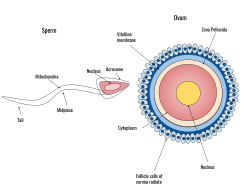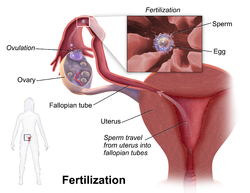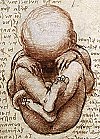| Human fertilization | |
|---|---|
 Sperm about to enter the ovum with acrosomal head ready to penetrate the zona pellucida and fertilize the egg | |
 Illustration depicting ovulation and fertilization | |
| Details | |
| Days | 0 |
| Precursor | Gametes |
| Gives rise to | Zygote |
| Anatomical terminology | |
| Part of a series on |
| Human growth and development |
|---|
 |
| Stages |
| Biological milestones |
| Development and psychology |
Human fertilization is the union of an egg and sperm, occurring primarily in the ampulla of the fallopian tube.[1] The result of this union leads to the production of a fertilized egg called a zygote, initiating embryonic development. Scientists discovered the dynamics of human fertilization in the 19th century.[2]
The process of fertilization involves a sperm fusing with an ovum. The most common sequence begins with ejaculation during copulation, follows with ovulation, and finishes with fertilization. Various exceptions to this sequence are possible, including artificial insemination, in vitro fertilization, external ejaculation without copulation, or copulation shortly after ovulation.[3][4] Upon encountering the secondary oocyte, the acrosome of the sperm produces enzymes which allow it to burrow through the outer shell called the zona pellucida of the egg. The sperm plasma then fuses with the egg's plasma membrane and their nuclei fuse, triggering the sperm head to disconnect from its flagellum as the egg travels down the fallopian tube to reach the uterus.
In vitro fertilization (IVF) is a process by which egg cells are fertilized by sperm outside the womb, in vitro.
- ^ Spermatogenesis — Fertilization — Contraception: Molecular, Cellular and Endocrine Events in Male Reproduction. Ernst Schering Foundation Symposium Proceedings. Springer-Verlag. 1992. ISBN 978-3-662-02817-9.[page needed]
- ^ Garrison FH (1921). An Introduction to the History of Medicine. Saunders. pp. 566–567.
- ^ "Go Ask Alice!: Pregnant without intercourse?". Archived from the original on 2011-12-22. Retrieved 2016-01-24.
- ^ Knight B (1998). Lawyer's guide to forensic medicine (2nd ed.). London: Cavendish Pub. Ltd. p. 188. ISBN 978-1-85941-159-9.
Pregnancy is well known to occur from such external ejaculation ...